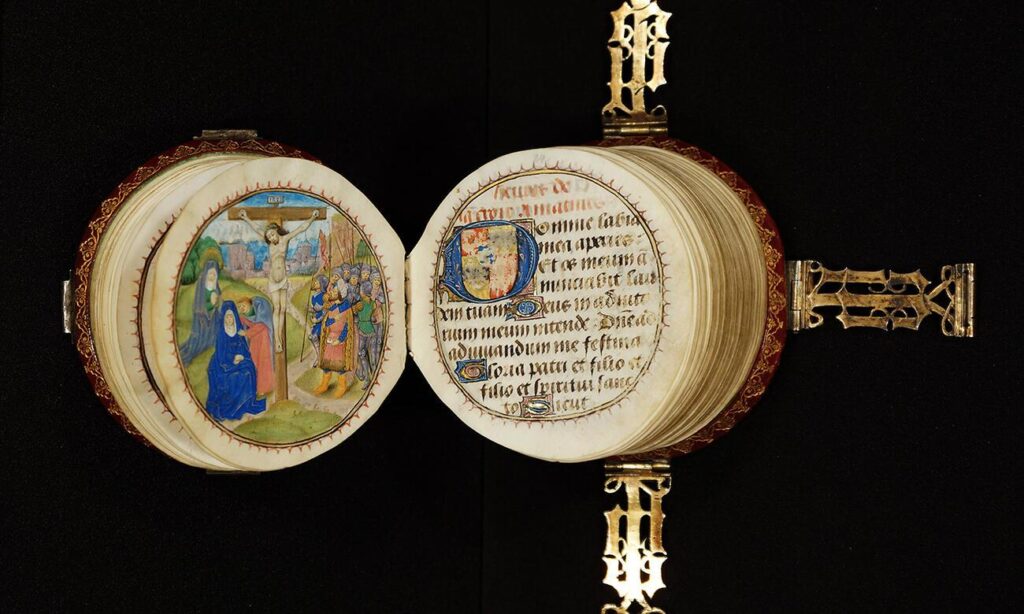The 15th century marked a golden age for illuminated manuscripts, with Flemish craftsmen at the forefront of this artistic tradition. Among their most unique creations is the Codex Rotundus, a circular masterpiece that stands out as both a devotional object and a work of unparalleled artistry. This pocket-sized Book of Hours offers a fascinating glimpse into the religious practices, linguistic diversity, and artistic innovations of late-medieval Europe.
The Unique Design of the Codex Rotundus
One of the most striking features of the Codex Rotundus is its circular shape, which sets it apart from traditional rectangular manuscripts. Measuring just 9 centimeters in diameter, this pocket-sized book was likely intended for personal devotion, allowing its owner to carry it easily. The round format may have held symbolic significance, evoking the perfection and eternity associated with the circle in medieval thought. Its unusual design also demonstrates the ingenuity of Flemish bookmakers, who pushed the boundaries of manuscript production.

A Lavishly Illuminated Book of Hours
The Codex Rotundus contains 266 pages, each meticulously crafted to create a harmonious balance between text and imagery. As a Book of Hours, it served as a guide for daily prayers and devotions, structured around the canonical hours of the day. The illuminations are particularly noteworthy, featuring:
- Intricate miniatures depicting biblical scenes, saints, and motifs.
- Decorative initials embellished with gold leaf and vivid pigments.
- Marginalia with floral designs and symbolic imagery.
These details reflect the high level of skill and creativity among Flemish craftsmen, who were renowned for their contributions to manuscript art during the period.
The Dual Language of Latin and French
Unlike many Books of Hours, which were often written in a single language, the Codex Rotundus incorporates both Latin and French. Latin, the language of the Church, underscored the manuscript’s sacred purpose, while French, a vernacular language, made its content accessible to a broader audience. This bilingual approach highlights the cultural and linguistic fluidity of the region, particularly in Flanders, a crossroads of trade and ideas during the 15th century.
Context and Significance
Flemish Craftsmanship in the 15th Century
The 15th century was a period of great innovation in manuscript production. Flemish illuminators, influenced by the Gothic style and the rise of Renaissance ideas, developed techniques that combined meticulous attention to detail with vibrant color palettes. The Codex Rotundus exemplifies this tradition, blending practicality with aesthetic brilliance.
Personal Devotion in Medieval Europe
Books of Hours were highly personalized objects, often commissioned by wealthy patrons. Their small size and portable nature allowed for private worship, reflecting the growing emphasis on individual piety during the late Middle Ages. The Codex Rotundus, with its unique shape and exquisite design, would have been a prized possession, symbolizing both religious devotion and social status.

Modern Legacy and Preservation
Today, the Codex Rotundus is a valuable historical artifact, preserved in museum collections and studied by scholars. It offers insights into the spiritual life, artistic achievements, and cultural dynamics of its time. The manuscript’s survival also highlights the enduring legacy of medieval craftsmanship and the importance of preserving these treasures for future generations.
Why the Codex Rotundus Matters
The Codex Rotundus is more than just a book; it is a window into a world where art, faith, and culture intersected. Its circular form challenges our understanding of medieval design conventions, while its illuminations reveal the depth of Flemish artistic traditions. By examining this extraordinary manuscript, we gain a deeper appreciation for the creativity and devotion that shaped the Middle Ages.
The Codex Rotundus stands as a testament to the ingenuity of 15th-century Flemish craftsmen. Its beauty, rarity, and historical significance continue to captivate modern audiences, reminding us of the timeless connection between art and faith.
Video
